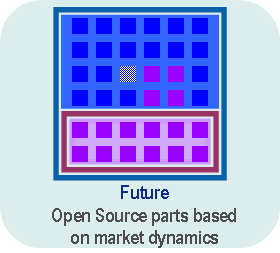Dana Blankenhorn recently blogged about IBMs reaction to Sun’s Java plan and their approach to the open source ecosystem. I think Dana summarizes it very well. IBM believes Open Source is a great technology floor on which others and even IBM builds. But as Dana points out, it is naive to treat IBM as a Solutions and Services company with the rest of the software industry players, primarily software vendors like Oracle, SAP, RedHat, and Microsoft.
IBM is a very interesting player in the Open Source ecosystem and, in my opinion- The Best. They understand how it works and how to leverage it to their business goals. To their customers, they are perceived as the trusted business partner, and it helps immensely to be portrayed as open and flexible. They are brilliant about where to contribute to open source and get influence and what/how to consume that meets their business objective. And the wonderful thing is that they had been able to pull this off by not ruffling many feathers in the community.
In the changing software landscape of open-source, the core competency is not “ S/W features” but “Speed” - Speed by which a firm can leverage external innovations not by copying everything but by quickly assembling products from proprietary and open components.
In my opinion, IBM believes that in the long run, all software will be free and open and hence does not have much value in itself. But the trick is to extract as much value as possible during the journey to the end state. And to do that, they leverage “Pluggable Integration Architecture," a “Lego blocks” type approach that can accommodate both proprietary and open source components. Pluggable Integration Architecture is the new influence point and allows “opening” their existing S/W product portfolio in increments and on their terms.

Eclipse showed how robust pluggable architecture could be. Certainly owning (in other words, heavily influencing) the integration platforms that allow mixing open and closed components form the core to their strategy. In 1990 IBM tools were dismal, but over time, by using Eclipse to build a common integration framework, IBM transformed its tools business. In the beginning, Eclipse was a blob below proprietary WebSphere, but over time the integration framework has been meshed into proprietary code, positioning them well for the future.
This changes the competitive landscape, now if the market environment changes either from competitive pressure or by the availability of better open source components, IBM now has a mechanism to respond fast. IBM can easily slot in components from open source (like Apache httpd) and commoditize components when it sees competitive threats (like modeling tools). By getting the industry to adopt an open integration framework, they have a channel to slot in proprietary pieces on top of open pieces. IBM is in a position to extract value on the road towards “Total Commoditization.”

After having standardized the integration framework for tooling and IDE, IBM is now trying to do the same for runtimes. Geronimo is a great effort in that direction. It will be interesting to see how that plays out. Already there are signs that it doing very well
(Report: IBM Open Source-Based Application Server Growing Nearly Three Times Faster Than JBoss).
And regarding Java, I believe very soon IBM will get over the gloom and then it will embrace it to make it yet another Lego block in the puzzle.
Originally posted at Blogspot on 2006-11-28 11:37:00 +0000 UTC